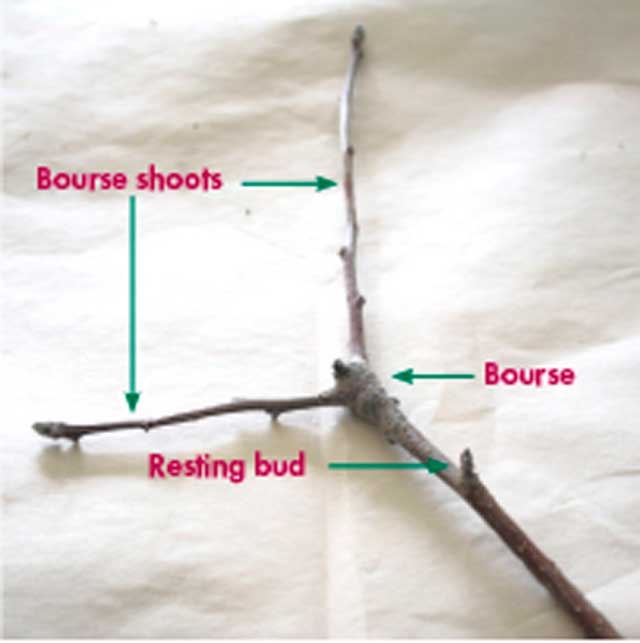Bourse shoots can grow to about 25 mm or more. Sometimes the bourse bud may form another small whorl of leaves ending into another bourse bud, which is a resting bud and will not flower the following season.
Bourse shoots (cont. from last month)
Early in the season, the growing bourse shoots may compete with the developing fruits for nutrient reserves and assimilated carbohydrates produced by the spur leaves.
If bourse shoots grow too vigorously due to too much nitrogen fertiliser in spring, they become strong competitors and fruit set may be reduced.
The ability of the bud to set fruit is closely related to the size of the bud in winter. As the diameter of the bud increases, its potential to set fruit also increases. A bullet-shaped bud is a strong bud and will most likely contain a full cluster of flowers and 1 or 2 bourse shoots. Bud size relates to the spur leaf area and development of the ovary, which are both important for fruit set.
Small pointy buds are often of poor quality and result from too much or a lack of tree vigour, a heavy crop load in the previous season and/or poor tree nutrition.
Mixture of spurs
In a well-managed orchard, there is a mixture of resting spurs and spurs with strong, big flower buds.
The best and strongest flower buds start to form in early to mid-summer and continue to develop for the remainder of the season until bloom the following spring.
By the end of April all the floral parts of individual flowers in the apple cluster can be seen under a microscope, such as the king flower and 5 or 6 lateral flowers.
Well-developed mature buds open the following spring with a full complement of medium-sized spur leaves and 5 to 6 flowers. These flower clusters readily set fruit, form bourse shoots and fruit is of good size.
During the period when development of flower buds is very active (early to mid-summer), many factors affect the bud and influence its potential to be a strong bud with a strong cluster of flowers.
As flower buds develop for 200 to 300 days of the year, you actually manage two crops in the one season. While you are busy managing the current season’s crop, the potential crop for the next season are already developing.
Spur leaves
Spur leaves are very important for fruit set and early fruit development.
(cont. next issue)
See this article in Tree Fruit September 2018






















